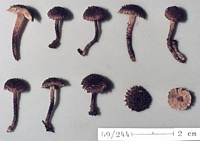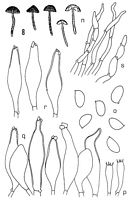|
 Inocybe phaeosquarrosa Inocybe phaeosquarrosa
BiostatusPresent in region - Indigenous. Endemic
Images (click to enlarge)
Caption: ZT69-244: INOCYBE PHAEOSQUARROSA
Owner: Egon Horak | 
Caption: Inocybe phaeosquarrosa (type): n, carpophores;
o, spores; p, basidia; q, cheilocystidia;
r, pleurocystidia; s, cuticle. | 
Caption: Dried type specimen
Owner: Herb PDD |
Article: Horak, E. (1978) [1977]. Fungi Agaricini Novaezelandiae. VI. Inocybe (Fr.) Fr. and Astrosporina Schroeter. New Zealand Journal of Botany 15(4): 713–747 (http://www.rsnz.org/publish/abstracts.php).
Description: Pileus 5-15 mm diam., hemispherical becoming
convex, margin incurved; dark brown, umber brown, equally coloured; dry, densely
covered with concolorous, squarrose, coarse scales and squamules all over, estriate
margin appendiculate, veil remnants absent. Lamellae emarginate-adnate, or adnexed,
ventricose, crowded (L-20, 1-5); whitish when young turning pale brown to pale
rust brown, edge albofimbriate. Stipe 15-25 x 1-1.5 mm, cylindrical, equal;
concolorous with pileus or darker (especially at base), apex pubescent, towards
base with concolorous coarse scales and squamules (like surface or pileus);
dry, hollow, single and cespitose. Context dark brown beneath cuticle and at
base of stipe. Odour and taste acidulous. Chemical reactions on pileus: KOH-negative.
Spores 6.5-7.5 x 4-4.5 µm, ovate, brown and
smooth. Basidia 20-26 x 6-7 µm, 4-spored. Cheilocystidia and pleurocystidia
35-65 x 12-16 µm, fusoid to lageniform, thin-walled, hyaline, encrusted with
crystals. Caulocystidia -100 x -10 µm, cylindrical to subfusoid, not well differentiated,
hyaline, crystals absent. Cuticle a trichoderm of cylindrical hyphae (5-14 µm
diam.), membranes occasionally thick-called (especially in terminal cells),
encrusted with brown (KOH) pigment. Clamp connections numerous.
Habitat: On rotten wood and bark of Nothofagus,
N. cliffortioides. New Zealand.
Notes: Among the New Zealand species of Inocybe,
I. phaeosquarrosa is the only one with thin-walled cheilo- and pleurocystidia.
Furthermore the taxon is well characterised by the coarse warts and scales towards
the base of the stipe (cf. I. scabriuscula).
|